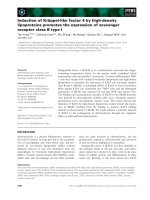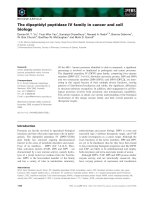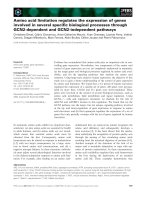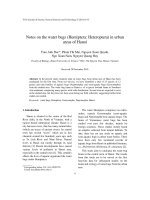Effects of high glucose concentrations on the expression of genes involved in proliferation and cell fate specification of mouse embryonic neural stem cells
Bạn đang xem bản rút gọn của tài liệu. Xem và tải ngay bản đầy đủ của tài liệu tại đây (3.4 MB, 257 trang )
EFFECTS OF HIGH GLUCOSE CONCENTRATIONS ON
THE EXPRESSION OF GENES INVOLVED IN
PROLIFERATION AND CELL-FATE SPECIFICATION
OF MOUSE EMBRYONIC NEURAL STEM CELLS
FU JIANG
NATIONAL UNIVERSITY OF SINGAPORE
2006
EFFECTS OF HIGH GLUCOSE CONCENTRATIONS ON
THE EXPRESSION OF GENES INVOLVED IN
PROLIFERATION AND CELL-FATE SPECIFICATION
OF MOUSE EMBRYONIC NEURAL STEM CELLS
FU JIANG
(MD, MMed)
A THESIS SUBMITTED FOR THE DEGREE OF
DOCTOR OF PHILOSOPHY
DEPARTMENT OF ANATOMY
YONG LOO LIN SCHOOL OF MEDICINE
NATIONAL UNIVERSITY OF SINGAPORE
2006
ACKNOWLEDGEMENTS
I would like to express my deepest appreciation to my supervisor, Dr S
Thameem Dheen, Department of Anatomy, National University of Singapore, for his
invaluable guidance, innovative ideas, friendly criticisms and constant encouragement
throughout the course of the study.
I am greatly indebted to Professor Ling Eng Ang, Head, Department of
Anatomy, National University of Singapore, for his full support in providing me with
the excellent research facilities and a fascinating academic environment.
I am also grateful to Associate Professor Tay Sam Wah Samuel, Deputy
Head, Department of Anatomy, National University of Singapore, for his constant
encouragement, valuable advice and constructive criticism.
I must acknowledge my gratitude to Mrs Yong Eng Siang and Mrs Ng Geok
Lan for their excellent technical assistance, Mr Yick Tuck Yong for his assistance in
computer work, Mr Lim Beng Hock for looking after the experimental animals, and
Ms Ang Lye Geck Carolyne, Ms Diljit Kaur d/o Bachan Singh, and Ms Teo Li Ching
Violet for their secretarial assistance.
I would like to thank all other staff members, my fellow postgraduate students
in the Department of Anatomy, National University of Singapore for their help and
support. I am also thankful to Sanwa Kagaku Kenkyusho Co., Ltd., Japan for
providing fidarestat. Certainly, without the financial support from the National
University of Singapore, this work would not have been brought to a reality.
I would like to take this opportunity to express my heartfelt thanks to my
parents, my sister and brother for their full and endless support through the years.
i
Finally, I am greatly indebted to my wife, Ms Gao Qing for her understanding
and encouragement during my study.
ii
This thesis is dedicated to
my beloved family
iii
PUBLICATIONS
Various portions of the present study have been published or submitted for
publication.
International Journals:
J. Fu, S. S. W. Tay, E. A. Ling, S. T. Dheen. High glucose alters the expression of
genes involved in proliferation and cell-fate specification of embryonic neural stem
cells. Diabetologia (2006) 49: 1027-1038
J. Fu, S. S. W. Tay, E. A. Ling, S. T. Dheen. Aldose reductase is implicated in high
glucose-induced oxidative stress in mouse neural stem cells. J. Neurochem. (In
revision)
Conference Abstracts:
J. Fu, S. S. W. Tay, E. A. Ling, S. T. Dheen (2004) Analysis of proliferation and
differentiation of neural stem cells in a high glucose environment. American Society
for Biochemistry and Molecular Biochemistry Annual Meeting and 8th International
Union of Biochemistry and Molecular Biology Conference, Abstract Number 254, 1216 June, Boston, MA, USA.
J. Fu, S. S. W. Tay, E. A. Ling, S. T. Dheen (2004) Characterization of embryonic
neural stem cells exposed to high glucose concentration. 8th NUS-NUH Annual
Scientific Meeting, Abstract Number P-22, Page 89, 7-8 October, Singapore.
J. Fu, S. S. W. Tay, E. A. Ling, S. T. Dheen (2004) Effects of high glucose
concentration on the proliferation and differentiation of neural stem cells.
International Biomedical Science Conference, Abstract Number P08, Page 78, 3-7
December, Kunming, China.
J. Fu, S. S. W. Tay, E. A. Ling, S. T. Dheen (2005) High D-glucose induces oxidative
stress and alters expression of genes involved in proliferation and cell fate
specification of embryonic neural stem cells. Society for Neuroscience 35th Annual
Meeting, Abstract Number 24.10 (24 Neural Stem Cells in Brain Injury and Disease,
Theme A, A10), 12-16 November, Washington, DC, USA.
J. Fu, S. S. W. Tay, E. A. Ling, S. T. Dheen (2005) Abnormal proliferation and
differentiation of neural stem cells exposed to high glucose are associated with altered
gene expression and oxidative stress. International Neuroscience Conference,
Abstract Number AP32, 26-29 November, Al Ain, United Arab Emirates.
iv
TABLE OF CONTENTS
ACKNOWLEDGEMENTS ·····················································································i
DEDICATION·········································································································iii
PUBLICATIONS ····································································································iv
TABLE OF CONTENTS ························································································v
ABBREVIATIONS ·······························································································xiii
SUMMARY ···········································································································xvi
LIST OF TABLES ·································································································xx
LIST OF ILLUSTRATIONS ···············································································xxi
LIST OF FIGURES ·····························································································xxii
CHAPTER 1: INTRODUCTION··········································································· 1
1. General background of diabetes mellitus······························································2
1.1. Complications associated with diabetes mellitus ·········································3
1.2. Maternal diabetes and congenital malformation ··········································4
1.3. Maternal diabetes-induced neural tube defects ············································5
2. Molecular mechanisms of neural tube development·············································6
2.1. Development of the neural tube···································································6
2.2. Factors involved in neural tube development ··············································9
2.2.1. Morphogens······················································································10
2.2.1.1. Sonic hedgehog········································································11
2.2.1.2. Bone morphogenetic proteins ··················································12
2.2.2. Notch signaling pathway ··································································14
v
2.2.3. bHLH transcription factors ·······························································15
2.2.3.1. Hes1 and Hes5 ·········································································15
2.2.3.2. Neurog1/2 and Ascl1 ·······························································17
2.2.3.3. Olig1 and Olig2 ·······································································19
3. Hyperglycemia-associated molecular and cellular changes ································20
3.1. Changes in cellular glucose uptake····························································21
3.2. Hyperglycemia-induced oxidative stress ···················································22
3.3. Alterations in signaling pathways······························································24
3.4. Cellular changes ························································································26
4. Experimental models to study the pathogenesis of maternal diabetes-induced neural
tube defects ······································································································26
4.1. Diabetic animal models ·············································································27
4.2. Neural stem cell (NSC) culture··································································29
5. Specific Aims ·····································································································31
CHAPTER 2: MATERIALS AND METHODS ················································· 34
1. Animals ··············································································································35
2. Induction of diabetes mellitus in mice ································································36
2.1. Materials····································································································36
2.2. Procedure···································································································36
3. Blood glucose test ······························································································36
4. Collection of embryos ························································································37
4.1. Materials····································································································37
vi
4.2. Procedure···································································································38
5. Histology············································································································39
5.1. Materials····································································································39
5.2. Procedure···································································································39
6. Primary culture of neural stem cell (NSC) ·························································40
6.1. Materials····································································································40
6.2. Procedure···································································································41
7. Differentiation of NSCs······················································································41
7.1. Materials····································································································41
7.2. Procedure···································································································42
8. Treatment of NSCs·····························································································43
8.1. Materials····································································································43
8.2. Procedure···································································································43
9. Assay of cell viability·························································································44
9.1. Principle ····································································································44
9.2. Materials····································································································44
9.3. Procedure···································································································45
10. TUNEL analysis to detect apoptosis·································································46
10.1. Principle ··································································································46
10.2. Materials··································································································47
10.3. Procedure·································································································47
11. Analysis of proliferation index ·········································································48
11.1. Principle ··································································································48
vii
11.2. Materials··································································································49
11.3. Procedure·································································································50
12. Fluorescent immunohistochemistry··································································51
12.1. Principle ··································································································51
12.2. Materials··································································································53
12.3. Procedure·································································································54
13. Isolation of RNA and Real time reverse transcription- polymerase chain reaction
(RT-PCR) ·········································································································55
13.1. Principle ··································································································55
13.1.1. Polymerase chain reaction (PCR) ···················································55
13.1.2. Isolation of total RNA·····································································57
13.2. Materials··································································································58
13.3. Procedure·································································································58
13.3.1. Extraction of total RNA ··································································58
13.3.2. cDNA synthesis ··············································································59
13.3.3. The real time RT-PCR ····································································59
13.3.4. Image of PCR products···································································59
14. In situ hybridization··························································································61
14.1. Principle ··································································································61
14.2. Preparation of cRNA probes····································································61
14.3. Preparation of competent cells·································································62
14.3.1. Materials·························································································62
14.3.2. Procedure························································································63
viii
14.4. Transformation of competent cells with plasmid ·····································63
14.4.1. Materials·························································································63
14.4.2. Procedure························································································64
14.5. Linearization of the plasmid ····································································65
14.5.1. Materials·························································································65
14.5.2. Procedure························································································65
14.6. In vitro transcription ················································································65
14.6.1. Materials·························································································65
14.6.2. Procedure························································································66
14.7. In situ hybridization using cell cultures ···················································66
14.7.1. Materials·························································································66
14.7.2. Procedure························································································68
15. Estimation of reactive oxygen species (ROS) in NSCs ····································69
15.1. Principle ··································································································69
15.2. Materials··································································································70
15.3. Procedure·································································································70
16. Western blot analysis························································································71
16.1. Principle ··································································································71
16.2. Materials··································································································72
16.3. Procedure·································································································74
17. Statistical analysis ····························································································76
CHAPTER 3: RESULTS ······················································································77
ix
1. Neural tube defects observed in embryos of diabetic mice ·································78
2. High glucose disturbs the growth, survival, and cell fate specification of NSCs ····
··············································································································78
2.1. NSCs derived from mouse embryonic telencephalon in culture ················78
2.2. Viability, apoptosis and proliferation of NSCs and differentiated cells in high
glucose environment···················································································79
2.3. Cell fate specification of NSCs exposed to high glucose ···························80
2.4. Cell proliferation and neuronal differentiation of NSCs in the telencephalon
of E11.5 embryos of diabetic mice ·····························································81
3. High glucose altered the expression of developmental control genes in NSCs and
differentiated cells ····························································································83
3.1. Morphogens·······························································································83
3.1.1. Shh····································································································83
3.1.2. Bmp4 ································································································84
3.2. Molecules of Notch pathway ·····································································85
3.2.1. Dll1···································································································85
3.2.2. Hes1··································································································86
3.2.3. Hes5··································································································87
3.3 bHLH transcription factors ·········································································87
3.3.1. Neurog1/2·························································································87
3.3.2. Ascl1 ································································································89
3.3.3. Olig1/2······························································································90
4. High glucose induced oxidative stress in NSCs··················································92
x
4.1. Generation of ROS in NSCs exposed to high glucose ·······························92
4.2. Expression of aldose reductase was altered in NSCs exposed to high glucose
··············································································································92
4.3. Effect of fidarestat on ROS production in NSCs exposed to different glucose
concentrations·····························································································93
4.4. Expression of Glut1 in NSCs was altered by high glucose and oxidative stress
··············································································································93
4.5. Effect of fidarestat on viability, proliferation and apoptosis of NSCs exposed
to high concentrations of glucose ·······························································95
CHAPTER 4: DISCUSSION ················································································97
1. High glucose alters the expression of genes involved in the proliferation and cell
fate specification of embryonic NSCs ······························································99
1.1. High glucose impairs the proliferation and survival of NSCs ····················99
1.2. High glucose promotes the neuronal and glial differentiation of NSCs ···102
2. Aldose reductase is implicated in high glucose- induced oxidative stress in NSCs
············································································································105
2.1. High glucose induces oxidative stress in NSCs via polyol pathway ········106
2.2. High glucose impairs the survival and proliferation of NSCs via oxidative
stress·········································································································107
2.3. High glucose alters the expression of Glut1 in NSCs ······························107
xi
CHAPTER 5: CONCLUSION············································································ 110
REFERENCES·····································································································122
FIGURES ·············································································································· 145
APPENDIX··········································································································· 220
xii
ABBREVIATIONS
AGEs, advanced glycation end products
AP, alkaline phosphatase
AR, aldose reductase
Ascl1, achaete-scute complex-like 1
BCIP, 5-bromo-4-chloro-3-indoly phosphate
bHLH, basic helix-loop-helix
BMP, bone morphogenetic protein
BrdU, bromodeoxyuridine
CNS, central nervous system
DAG, diacylglycerol
DAPI, 4’, 6- diamidino-2-phenylindole dihydrochloride
DC, differentiated cell
DEPC, diethyl pyrocarbonate
DIG, digoxigenin
DLHP, dorsolateral hinge point
Dll1, delta like 1
DM, diabetes mellitus
DMEM, Dulbecco's modified eagle medium
DRG, dorsal root ganglion
EGF, epidermal growth factor
FBS, fetal bovine serum
FGF, fibroblast growth factor
xiii
GAPDH, glyceraldehyde-3-phosphate dehydrogenase homolog
GDM, gestational diabetes mellitus
GFAP, glial fibrillary acidic protein
Glut1, glucose transporter 1
H2DCF-DA, 2’, 7’-dichlorodihydrofluorescein diacetate
HG, high concentration of glucose
HRP, horseradish peroxidase
IDDM, insulin- dependent diabetes mellitus
IHC, immunohistochemistry
ITS, insulin-transferrin-selenium supplements
Hes, hairy and Enhancer of split
MAP2, microtubule-associated protein 2
MAPK, mitogen-activated protein kinase
MHP, median hinge point
M-MLVRT, molony- murine leukemia virus reverse transcriptase
NADPH, nicotinamide adenine dinucleotide phosphate
NBT, nitro blue tetrazolium
Neurog1/2, neurogenin1/2
NF-κB, nuclear factor-κB
NG2, chondroitin sulfate proteoglycan
NIDDM, non- insulin- dependent diabetes mellitus
NSC, neural stem cell
NTD, neural tube defect
xiv
PBS, phosphate-buffered saline
PCR, Polymerase chain reaction
PF, paraformaldehyde
PG, physiological concentration of glucose
PI, propidium iodide
PKC, protein kinase C
Ptc, patched
PVDF, polyvinylidene fluoride
ROS, reactive oxygen species
RT-PCR, reverse transcription- polymerase chain reaction
SDS, sodium dodecyl sulfate
Shh, sonic hedgehog
Smo, smoothened
STZ, streptozotocin
SVZ, subventricular zone
TBS, Tris buffered saline
TGF-β, transforming growth factor β
TUNEL, TdT-mediated dUTP nick end labeling
Wnt, wingless- type gene
xv
SUMMARY
Epidemiological studies and experiments in rodent embryos revealed that there is an
increased risk for fetal malformations and spontaneous abortions in diabetic
pregnancy. Diabetic embryopathy is a complication of maternal diabetes in which the
embryo from a diabetic pregnancy develops congenital malformations in various
organ systems, including cardiovascular, gastrointestinal, genitourinary, and nervous
systems, among which the neural tube defects were frequently demonstrated. Though
details of disease pathogenesis are complex, recent studies have demonstrated that
altered expression of developmental control genes contribute to the neural tube
defects (NTD) in embryos of diabetic mice.
The neural tube patterning occurs early concomitantly with the neural
induction. Since the neural tube has been shown to be derived from NSCs, which are
self-renewing, multipotent progenitors, giving rise to different cell types such as
neurons, astrocytes and oligodendrocytes that compose the nervous system, it is
possible that maternal diabetes influences the proliferation and differentiation of
NSCs leading to alteration of the lineage specification that determines the size, shape
and histogenesis of the neural tube. Hence it was hypothesized that maternal diabetes
alters the expression of some developmental control genes leading to abnormal
proliferation and cell fate choice of NSCs, thereby resulting in patterning defect
during the neural tube development. In order to address this, the present author has
investigated the effect of high concentrations of glucose on the growth, survival,
proliferation and cell-fate specification of NSCs isolated from the telencephalon of
embryonic mice, and on the expression of some developmental control genes such as
xvi
sonic hedgehog (Shh), bone morphogenetic protein 4 (Bmp4), neurogenin 1/2
(Neurog1/2), achaete-scute complex-like 1 (Ascl1), oligodendrocyte transcription
factor 1 (Olig1), oligodendrocyte lineage transcription factor 2 (Olig2), hairy and
enhancer of split 1/5 (Hes1/5) and delta-like 1 (Dll1) in NSCs and their differentiated
progeny cells.
In the present study, NSCs were exposed to media containing either
physiological glucose concentration (PG, 5mmol/l) or high concentration of glucose
(HG, 30 or 45mmol/l). Cell viability, proliferation index and apoptosis of NSCs and
differentiated cells exposed to PG or HG medium were examined by the tetrazolium
salt assay, 5-bromo-2’-deoxyuridine (BrdU) labeling, terminal deoxynucleotidyl
transferase-mediated dUTP nick end labeling (TUNEL) and immunocytochemistry.
Expression of developmental control genes including Neurog1, Neurog2, Ascl1,
Olig1, Olig2, Hes1, Hes5 and Dll1 as well as Shh and Bmp4, were analyzed by the
real time RT-PCR and in situ hybridization in NSCs and differentiated cells exposed
to PG and HG medium. Proliferation index and neuronal specification in the forebrain
of embryos at embryonic day 11.5 were examined histologically. High concentration
of glucose was found to impair the survival and proliferation efficiency and promote
precocious neuronal and glial differentiation from NSCs.
These changes were
associated with the altered mRNA expression of genes involved in neurogenesis and
gliogenesis, such as Shh, Bmp4, Neurog1/2, Ascl1, Hes1/5, Dll1 and Olig1.
Further, it has been shown that the earliest response to high glucose challenge
in many cell types including embryonic neural tissues is the induction of oxidative
stress, which is one of the suggested key factors responsible for maternal diabetes-
xvii
induced congenital malformations, including NTD in embryos. However, the
mechanisms by which maternal diabetes induces oxidative stress in NSCs during
neurulation are not clear. The present study was aimed to investigate whether high
glucose induces oxidative stress in NSCs, and the mechanism by which high glucose
alters the growth and survival of NSCs in vitro.
High glucose induced generation of reactive oxygen species which contributes
to the oxidative stress in NSCs. The mRNA expression of aldose reductase (AR),
which catalyzes the glucose reduction through polyol pathway, was increased in
NSCs exposed to HG medium. The mRNA and protein expression of glucose
transporter 1 (Glut1) which regulates glucose uptake in NSCs was increased at early
stage (24h) and became downregulated at late stage (72h) of exposure to HG medium.
Inhibition of AR by fidarestat, an AR inhibitor, decreased the oxidative stress,
restored the cell viability and proliferation, and reduced apoptosis in NSCs exposed to
HG medium. Moreover, inhibition of AR attenuated the downregulation of Glut1
expression in NSCs exposed to HG medium for 72 hours. These results suggest that
the activation of polyol pathway plays a role in the induction of oxidative stress which
alters Glut1 expression and cell cycle progression in NSCs exposed to high glucose,
thereby resulting in abnormal patterning of the neural tube in embryos of diabetic
pregnancy.
In conclusion, the present study demonstrates that high glucose medium alters
the expression of genes that are involved in cell cycle progression and cell fate
specification of the NSCs and differentiated cells leading to increased neuro- and gliogenesis. In addition, high glucose alters the polyol pathway by inducing the
xviii
expression of AR leading to intracellular metabolic disturbances and oxidative stress
which could further contribute to altered expression of developmental control genes
including Glut1, thereby resulting in abnormal viability and proliferation of NSCs.
These changes are speculated to mimic the events that occur during the
neurodevelopment in embryos of diabetic pregnancies, and may form the basis for
defective neural tube patterning observed in embryos of diabetic women.
xix
LIST OF TABLES
Table 1. Adult Swiss Albino mice used in this study··············································35
Table 2. Embryonic mice used in this study ···························································35
Table 3. Primers and reaction conditions for real time RT-PCR·····························60
xx
LIST OF ILLUSTRATIONS
Illustration 1. Mechanisms of neural tube closure in mouse and human···················9
Illustration 2. Schematic summary of the effects of high glucose on the expression of
developmental control genes that are involved in proliferation, survival
and differentiation of neural stem cells ·········································116
Illustration 3. Illustration showing high glucose-induced oxidative stress and altered
expression of developmental control genes in neural stem cells ···119
xxi
LIST OF FIGURES
Figure 1. Mouse embryos obtained from normal and diabetic pregnancy ···········146
Figure 2. NSCs derived from the telencephalon of mouse embryo······················148
Figure 3. Differentiation of NSCs ·······································································151
Figure 4. HG reduced viability of NSCs······························································154
Figure 5. HG inhibited proliferation of NSCs······················································156
Figure 6. HG induced apoptosis in NSCs ····························································158
Figure 7. Effects of HG on viability of differentiated cells from NSCs···············160
Figure 8. Effects of HG on proliferation of differentiated cells from NSCs ········162
Figure 9. Effects of HG on apoptosis of differentiated cells from NSCs ·············164
Figure 10. HG promoteed neuronal and glial differentiation of NSCs··················166
Figure 11. BrdU and MAP2 staining in the forebrain of mouse embryos·············169
Figure 12. Shh mRNA expression in NSCs and differentiated cells ·····················172
Figure 13. Bmp4 mRNA expression in NSCs and differentiated cells··················175
Figure 14. Dll1 expression in NSCs and differentiated cells ································178
Figure 15. Hes1 expression in NSCs and differentiated cells ·······························181
Figure 16. Hes5 expression in NSCs and differentiated cells ·······························184
Figure 17. Neurog1 mRNA expression in NSCs and differentiated cells ·············187
Figure 18. Neurog2 mRNA expression in NSCs and differentiated cells ·············190
Figure 19. Ascl1 mRNA expression in NSCs and differentiated cells ··················193
Figure 20. Olig1 mRNA expression in NSCs and differentiated cells ··················196
Figure 21. Olig2 mRNA expression in NSCs and differentiated cells ··················199
Figure 22. Intracellular ROS production in NSCs ················································202
xxii
Figure 23. AR mRNA expression in NSCs ··························································204
Figure 24. Inhibition of AR attenuated ROS in NSCs exposed to HG··················206
Figure 25. Glut1 mRNA expression in NSCs ·······················································208
Figure 26. Glut1 protein expression in NSCs ·······················································210
Figure 27. Localization of Glut1 protein in NSCs ················································212
Figure 28. Inhibition of AR restored viability of NSCs exposed to HG ···············214
Figure 29. Inhibition of AR reduced apoptosis in NSCs exposed to HG ··············216
Figure 30. Inhibition of AR increased proliferation of NSCs exposed to HG·······218
xxiii









